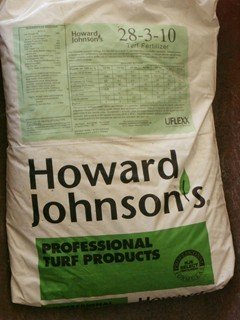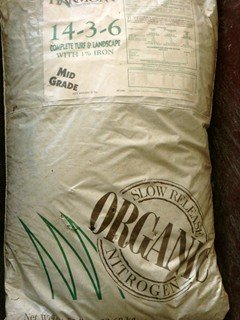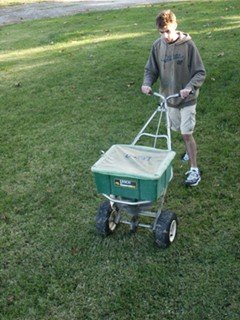Understanding Lawn Fertilizer
Beautiful lawns are not a product of nature, but are planned and created. Lawn fertilizer will always be an important part of the creation process. But there seems to be a lot of mystery around fertilizers, their purpose and what they do.
Choosing the right fertilizer begins by knowing what nutrients are currently in your soil, as determined by a soil test.
Soil nutrients, whether placed there by you or occur naturally work together to help grass perform one primary purpose. That is to perform photosynthesis. Photosynthesis is the process in which grass makes it own food.
In photosynthesis, the blades absorb the sunlight and the roots reach into the soil to obtain nutrients necessary to carry out its function. While this is a bit of an over-simplification, it is a complex system which we will not go deep into here.
Lawns that are not fertilized will have to rely completely on what is in the soil for all their nutrients. The soil around most homes these days, as you probably know, is not that good. After a house is built, contractors rarely consider the quality of the soil as anything important. As long as the lot is graded properly, that is all that matters.
Micronutrients and Macronutrients
Lawn grasses need several micronutrients and macronutrients to stay healthy and to perform necessary plant functions.
The list of micronutrients include Boron (B), Clorine (Cl), Copper (Cu), Iron (Fe), Manganese (Mn), Molybdenum (Mo), Nickel (Ni and Zinc (Zn). These are also referred to as trace elements. Most of the micronutrients, with the exception of iron, are usually not included in a bag of lawn fertilizer.
The primary macronutrients are Nitrogen (N), Phosphorus (P), and Potassium (K) and represent the most commonly used ingredients in lawn fertilizer. These three nutrients are very important for plant function and are the elements most deficient in soils. Other macronutrients include Calcium (Ca), Carbon (C), Hydrogen (H), Magnesium (Mg), Oxygen (O), and sulfur (S).
What Is In Lawn Fertilizer?
Have you ever thought about what is in fertilizer? The three numbers on a fertilizer bag represent the three primary macronutrients, which are Nitrogen, Phosphorus, and Potassium, in that order.
These 3 numbers on the bag represent the nutrients grass need in the greatest amounts. It doesn't mean the other nutrients are less important to the life and health of the grass, however.
More specifically, the numbers on the bag represent the percentage by weight that the bag contains of each element.
Note: Fertilizer manufacturers do a poor job explaining to consumers how to interpret the numbers on the bag. Many people think the numbers represent a ratio of some sort or that it shows how many pounds of nutrient are in the bag. Again, it is neither of these, but the percentage by weight of each ingredient.
For example, if the bag weighs 25 lbs and first number on the bag (Nitrogen) is 10, then the bag contains 2.5 lbs of Nitrogen. If the bag weighs 30 lbs and the first number is 20, then the bag would contain 6 lbs of Nitrogen.
Click on the Calculating Fertilizer Rates page to see simple mathematical formulas used by the turf industry. Using these formulas will give you the amount of ingredient actually in the bag. You can also calculate how much fertilizer you need to apply for different situations.
This is important because fertilizer programs are determined by lbs of Nitrogen per 1000 sq. ft. per year. If you know how much Nitrogen is actually in the bag and you know how much nitrogen per 1000 sq. ft. you want to apply, you can accurately plan your entire fertilization schedule for the year. You can apply the correct amount regardless of what percentage is in the bag.
Types of fertilizer

Synthetic fertilizers are the most often used types and come in liquid and granular forms. Granular fertilizers are the easiest to apply and require the least expensive equipment. All that is needed is a rotary or drop spreader.
Liquid Fertilizer
Liquid lawn fertilizer, except for the small hose end types like “Miracle Gro”, may require special equipment to apply. Most liquid fertilizers are reserved for professional companies due, in part, to the cost of application equipment to cover large areas quickly.
However, for small lawns you can use a hand held sprayer or backpack sprayer. For larger lawns, you can purchase 10 or 20 gallon sprayers at your local farm and home store. Most require a 12 volt battery to operate.
As far which fertilizer, liquid or dry, is best? For the most part, they both perform equally well. This Howard Johnson's fertilizer is sold only to licensed professionals, but many home owner varieties are available.
The effects of fertilizers on the environment, when used on turfgrass, is not as big a concern as people once thought. Click here for more information on fertilizers and the environment.
All Mineral vs Slow Release Lawn Fertilizer
However, not all fertilizers are created equally. Some are referred to as “all mineral”, which means all elements are released quickly as soon as water is applied.
All mineral lawn fertilizers are usually the least expensive and you can still purchase a 50lb bag for under $10.00 at some feed stores. These bags often contain no instructions for storage or safe use nor any information on how much to apply. A note on the bag of one I saw says you will need to write to the company for that information.
Due to the high salt content, they must be used carefully and watered in thoroughly after use to prevent any possible burning of the grass. These fertilizers do serve a good purpose for specific situations, but for most homeowners, better and safer lawn fertilizer is available.
Slow Release Nitrogen
More expensive fertilizers will contain higher quality ingredients and often more than one form of available nitrogen. Usually, at least one form of nitrogen in the bag will be slow release. By blending different ingredients with different release rates, they can be marketed as “spring”, “summer”, and “fall” or “winterizer” fertilizers. Click here for information on different sources of nitrogen along with the best ways of using them.
Organic Lawn Fertilizers

Organic fertilizers will naturally contain a larger array of micronutrients and can be purchased in different forms.
Certified Organic means the lawn fertilizer is “all natural” and contains no synthetic materials. However, it doesn't mean it is not processed. (Who really wants raw manure.) These products fertilize the grass slowly as the soil microorganisms break down the organic matter into elements the grass roots can take up. Organic lawn fertilizer is safe and because of the way it works makes it difficult to over fertilize.
Organic Types
- Milorganite - which is human sludge from the Milwaukee Sewage Treatment Plants. Very slow release and is used only in summer.
- Manure - Chicken, Turkey, Horse and Cattle products. More expensive products include Bat Guano.
- plant by products, such as corn gluten meal. Some commercial products use food wastes.
Bridge Products
Bridge products are organic fertilizers blended with synthetics.
Depending on the blend of lawn fertilizer you choose, some will contain as much as 90% organic matter and are blended to perform best for different times of the year. Soil microorganisms are the least active in cold weather and most active in summer, so summer blends will contain the highest amounts of organic matter. The synthetics blended with the organics will provide the grass with immediate nutrients in cooler weather.
Before you buy your first bag of fertilizer and start your fertilization program, it really helps to find out what is in your soil so you can correct any potential problems. Look below for links on how to take a soil sample and detailed information on how to read a soil analysis report. You can also find specific information on fertilization, lawn fertilizers and how to apply them.
Developing a Lawn Fertilization Program
Behind every beautiful lawn is a good lawn fertilization program. Whether it's a championship golf course or your home lawn, certain fundamentals always apply. Click here to begin planning your fertilization program.
Secrets to Using Less Fertilizer While Improving Uptake
Developing deep and far reaching grass roots is a major factor for increased nutrient uptake and less fertilization. Find specific and proven techniques for improved root growth.
Nitrogen Sources for a Green Lawn
Nitrogen is the most important element in lawn fertility. However, different types of fertilizers can deliver nitrogen differently. See what sources of nitrogen are available from organic to inorganic, as well as, when and how they are best used.
How Fertilizer Can Prevent Lawn Deterioration
Why is fertilizer important? This page answers that question and describes the basics of grass decline when left unfertilized. It offers alternative steps for maintaining a healthy lawn.
Organic Compost
Compost has many benefits including a source of nutrients. The right blend of organic compost also has a tremendous ability to suppress grass diseases. Find the specifics on what the compost should include, how much to apply and information on how to make it yourself.
Organic Biostimulants
Seaweed Extract (kelp), plant hormones, fish emulsion and other organic products are increasing being used in lawns and gardens. Find out what they are all about along with a few case studies that tested them.
How To Collect A Soil Sample
The first step in understanding what is in your soil is to take a soil sample. Click here to find out how to how to collect a soil sample that will deliver the best results.
Understanding the Soil Analysis Report
Understanding the soil analysis report can be difficult. Click here for an explanation of results commonly found of most reports.
Calculating Fertilizer Rates
One of the tough parts about fertilizing is knowing how much to put down. This page gives you simple mathematical formulas for determining the correct amounts in different situations.
Spreader Calibration Made Easy
Spreader calibration made easy! Knowing if your spreader is actually putting down the right amount is important for professionals and homeowners alike. This page offers all you need to know about calibrating your broadcast or drop spreader.
Lawn Fertilizer back to Lawn Care Academy Home




